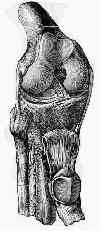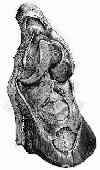
- See: Knee Joint Menu

- Patient Positioning and Preparation:
- positioning:
- opposite limb is well padded to prevent potential pressure problems;
- operative thigh is placed against an arthroscopy post or is placed in a circular thigh immobilizer;
- it is essential that the surgeon position the patient so that there is no difficulty in applying a valgus force to the knee while it remains in full extension (ie it does not move into flexion);
- without proper positioning, the knee will buckle into flexion as a valgus force is applied, and visualization of the posterior horn of the medial meniscus will be difficult;
- end of table may be dropped so that both limbs will dangle at 90 deg;
- tourniquet:
- generally a tourniquet is not necessary for routine knee arthroscopy, but its application is often useful when a hypertrophic fat pad requires debridement (such for management of chondral injuries);
- references:
- Postmeniscectomy tourniquet palsy and functional sequelae.
- Muscle rehabilitation after arthroscopic meniscectomy with or without tourniquet control. A preliminary randomized study.
- Effect of tourniquet ischaemia on muscle energy metabolism in meniscectomy patients.
- anesthesia:
- local anesthesia:
- indicated if only a simple arthroscopy is planned in a relatively thin patient;
- in obese patients w/ large thighs, local injection may further obscure the knee joint landmarks and may interfere with precise portal placement;
- consists of 30-50 ml of 1% lidocaine and 0.25% bupivacaine w/ epinephrine which is given under sterile conditions before the patient is prepped;
- the majority of the cocktail is given intra-articularly and about 6 cc is saved for the portals;
- it is essential to avoid injection into the deep subcutaneous tissue and the fat pad since this will cause the fat pad to swell and will interfere with visualization during the case;
- the majority of the local anesthetic is injected into the joint at a point well above the fat pad;
- the sudden "swoosh" of fluid into the joint confirms that the needle lies in the joint (and not fat pad);
- postoperative anesthesia:
- intra-articular narcotics: consider use of 5 cc of morphine prior to and at the end of surgery;
- IM Nsaids: consider IM Toradol;
- references:
- Intraarticular bupivacaine (Marcaine) after arthroscopic meniscectomy: a randomized double-blind controlled study.
- Knee arthroscopy using local anesthesia.
- Safety and efficacy of intra-articular bupivacaine and epinephrine anesthesia for knee arthroscopy.
- Outpatient arthroscopy of the knee under local anesthesia.
- inflow:
- may either use gravity system or the more preferred pump inflow system;
- if a pump inflow system is used be aware excessive inflow pressure may lead to fluid extravasation if there is a concomitant capsular tear;
- this can be partially prevented by applying a firm coband wrap around the leg and calf, which will resist extravasation of fluid
Current Concepts Review. Neurological Complications Due to Arthroscopy.
Injury to infrapatellar branch of saphenous nerve in arthroscopic knee surgery.
Arthroscopic posteromedial visualization of the knee.
Posterior portals for arthroscopic surgery of the knee.
Arthroscopy of the acute traumatic knee in children. Prospective study of 138 cases.
Septic arthritis following arthroscopy: clinical syndromes and analysis of risk factors.
Epinephrine-induced pulmonary edema during arthroscopic knee surgery. A case report.


